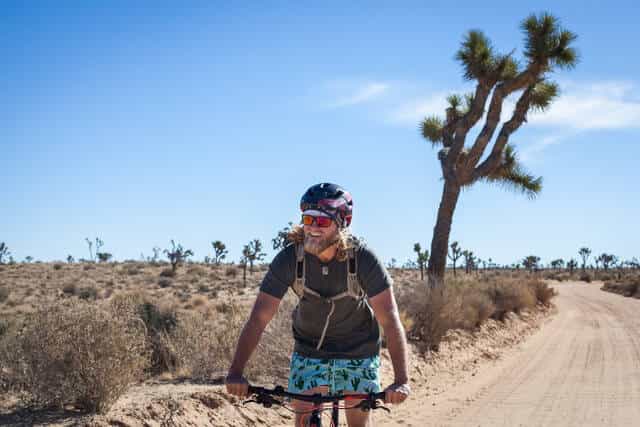Are you a mountain biker who is looking for the best protection possible? Have you ever wondered when and why you should be wearing a full face helmet while hitting the trails?
It’s no surprise; mountain biking is an inherently risky sport that requires proper protective gear. A full face helmet may provide the ultimate safety measure.
But when you notice most people not running full-face helmets, one can wonder whether they should reconsider investing in one.
After all, It’s quite a common sight at local trails to witness riders speeding down on downhill tracks, sporting regular mtb helmets instead of full-face.
Contrastingly, those equipped with full-face helmets are few and far between. One cannot help but question whether the necessity for full-face helmets is overestimated in the world of cycling.
In this blog post, we’ll look at what situations call for a full face helmet, explore their features and benefits, as well as discuss how they compare to regular bike helmets.
Whether you’re an experienced rider or just getting started on your off-road adventures — read on to find out if it’s time to invest in a full face helmet!
Are Full-Face Helmets Safer?
Undeniably, full-face helmets provide an unparalleled level of protection, covering not only the head but also the jaw, which is crucial for those who enjoy high-speed biking adventures.
Specially designed for downhill riders, these helmets have been inspired by motocross helmets that offer robust protection to riders whizzing past at tremendously high speeds.
As downhill biking involves elevated risks and higher speeds, a full-face helmet becomes a vital piece of equipment. Here is four reasons why full face helmets are safer:
1. More Coverage
The importance of wearing a full-face helmet while engaging in high-risk activities, such as mountain biking or extreme sports, cannot be overstated.
These helmets are specifically designed with a chin bar and additional protection around the rear of the helmet and above the ears to ensure maximum safety for the wearer.
An unfortunate face-first slide or collision with rocks or a trail can result in severe facial damage, which could’ve been prevented by wearing a full-face helmet.
Countless stories are shared by riders who regret not taking the necessary precautions to protect their faces from potential harm.
Moreover, the extra coverage provided by a full-face helmet not only shields the head from impacts and sharp objects but also significantly reduces the likelihood of a concussion or head injury.
A study published by Injury Epidemiology supports the notion that full-face helmets lower the risk of facial injury by two-thirds, proving that they indeed offer better protection against accidents / injury.

2. Dual Density Foam
The importance of a quality full-face helmet cannot be overstated when it comes to protecting yourself while riding a mountain bike downhill at speed.
One key feature to ensure ideal safety is the incorporation of Dual Density Foam, a relatively new technology that provides optimal protection from impacts.
This innovative foam consists of two distinct layers, each with its own purpose.
The outer layer, boasting a harder composition, serves to not only prevent sharp objects from penetrating the helmet but also to effectively dissipate energy during high-speed impacts.
Meanwhile, the inner foam layer possesses a softer foam covering that is essential in offering a more cushioned fall for the wearer.
This ingenious combination has been proven to significantly reduce the likelihood of head injuries up to an impressive 60%, making Dual Density Foam a vital component in any full-face helmet worth considering.
3. More Rigorous Testing and Standards
While all helmets in the U.S. must adhere to the CPSC standards, downhill helmets undergo a separate certification process known as ASTM F1952-15 to ensure optimum protection.
This means that although not all full-face helmets require downhill certification, the majority do possess it. Interestingly, helmets don’t necessarily have to be full-face to meet the downhill certification criteria.
One of the key tests within the ASTM F1952-15 standard focuses on evaluating the chin guard’s effectiveness, determining if the helmet passes or fails.
4. Additional Safety Consideration
The innovative advancements in full-face helmets have undoubtedly revolutionized the safety standards for mountain bikers.
Modern helmets now boast anti-rotational technology in their liners, which has a crucial role in minimizing the potentially damaging effects of rotational energy during an angled crash.
To achieve this, designs often feature an outer shell that rotates relative to the rider’s head, limiting the impact and providing greater protection.
Key examples of these state-of-the-art anti-rotational systems include MIPS, SPIN, Koroyd, and Turbine 360.
Additional safety measures have been implemented in modern helmets, such as providing sections of removable pads inside the chin guard to facilitate easier removal of an injured rider in emergency situations.
Moreover, the introduction of adjustable or breakaway visors significantly lowers the risk of neck injuries since they detach from the helmet during a crash.
Advantages of a Full-Face Over an Open-Face Helmet
Although it isn’t a must to don full-face helmets when riding XC or trail, they do have certain merits that make them worth considering.
From enhanced protection and improved comfort to better aerodynamics and excellent ventilation, discover the benefits of investing in one today!
- Full-face helmets provide greater protection as they cover the entire head and face. This means that in the event of an accident, less direct force is applied to the skull and other vital areas of your head. The chin guard also helps to protect against impact from below.
- Most full-face models come with added features such as built-in visors or goggles which offer additional protection against the elements, dust, and flying debris.
- The design of full-face helmets is more aerodynamic, reducing wind drag and allowing for greater speed.
- Full-face helmets are usually quieter than open-face models, as the visor helps to deflect noise away from the rider’s ears. This makes it easier to focus on the ride without any distractions.
- With a full-face helmet, your teeth and chin are entirely protected in case you get into trouble where you crash face-first. The hard shell of the helmet presents greater pierce resistance.
- Finally some full face helmets comes with anti-rotation features which help prevent the head from jerking or moving in any direction during a crash. ( Simply making them more safer! )
Related: Best Full Face Mountain Bike Helmet | Review & Comparison

If it’s Safer, Why Most People Not Running Full-Face Helmets.
Now, let’s talk about the reason why people still don’t like to wear full face helmets; even they have more safety reasons to do so and are even advised to wear on tough trails.
While safety should be everyone’s top priority when it comes to biking, many riders opt for the traditional open-faced helmet because of some practical and personal preferences.
Climbing is much more difficult with a full face since it can be quite hot and difficult to get enough oxygen; plus the additional weight of a full face can really slow someone down.
Open face helmets are significantly lighter than full face models, typically weighing 350g compared to an average of 800g. A notable difference that nudge riders to opt for open face helmets.
Additionally, visibility is compromised with a full face, as riders’ peripheral vision is limited by the additional coverage around the sides of their face.
For those who are doing all-mountain riding, being able to take in their surroundings quickly and keep a steady pace is essential, making an open-faced helmet often more desirable.
It’s the age-old tradeoff between risk and reward. For the reward of lighter weight, all around visibility, easier breathing and superior ventilation one have to take the risk of hitting your face on ground or rock with no protection. Some people will think the risk is worth it, some wont.
When to Wear Full Face Mountain Bike Helmet
If you often ride on tough trails, shuttles, or downhill riding, a full-face helmet is the best to wear. Don’t hesitate to wear a full-face helmet, even if it feels hot inside.
Wear a full-face mountain bike helmet if you have a fear of hitting your face and causing severe injury.
If you have preceding dental problems or just don’t want to spend savings for a dental or hospital bill, get a full-face mountain bike helmet.
Riders should consider wearing a full-face helmet if there is lots of speed and downhill riding to do. Instead of grabbing an open-face helmet, pick the full-face helmet.
It will provide extra protection, especially if you are heading out for your first trail ride. If you crash at high speed, a full-face helmet will better protect your jaw from getting seriously injured.
Wear a full-face helmet if you are a clumsy rider, and the odds of bike wrecks are no exception here. Sometimes, even the minutest rock on the road can send you flying and hitting the road.
It’s ok to be a clumsy rider or just too afraid for your security and not avoid a full-face helmet that can keep you free from scratches, injuries, and bruises.
Don’t fall for peer pressure and choose what best for you!
When to Wear Open Face Mountain Bike Helmet
Go for an open-faced mountain helmet; if you’re a casual rider, take easy trails and nothing too gnarly with limited risk of getting involved in an accident.
If you live in a warmer region, where the summers are extreme, wear an open face helmet.
Otherwise, you’ll sweat a lot. The open-faced helmets are way cooler because they are venting holes and most suitable for hot environments.
The open-face helmets are light in weight, so if you take long trips, get this type of helmet. They can be easily carried around anywhere and much easier to put-on and take-off in a fraction of a second.
These helmets are naturally quite airer and provide better visibility; you can even talk to the pillion riders when you stop. If you have a limited budget, then also purchase an open-face helmet.
Although the open-face helmets score less than the full-face helmets in terms of safety, buying a quality helmet, you’ll still enjoy great safety.
Things to Consider When Choosing a Mountain Bike Helmet?
Here are the important things to consider when buying a bike helmet, let’s check out:-
What Kind of Cycling Do You Do?
There are several types of helmets available in the market based on the usage; what kind of cycling you do. Whether it is city, all-terrain, downhill, light trails; each type has its type of helmet.
For cross-country mountain biking, easy local trails, where there are fewer chances of getting involved in an accident, wear an open face helmet, providing proper ventilation for long rides.
On the other hand, if you want to ride on tough trails, going down hill, riding at a higher speed, or ride technical trail with lots of climbing, consider going for a full face mountain bike helmet.
Know Your Helmet Size
Your helmet needs to be of appropriate size for both effectiveness and comfort in the event of an accident. There’s no rocket science; just measure your head size before you head on buying a helmet.
There are several options available, such as longer, round, or more curved, choose according to your head type, and so that it feels comfy.
Buy a helmet that comes with an adjustment wheel, which is at the helmet’s back to adjust the helmet quickly. If you don’t purchase a helmet that is of the right size, it might comes off in case of an accident.
Safety Concerns
In terms of safety, the full-face helmets present better coverage surrounding the neck and face. The full-face helmet protects the rider from anything external, whether it bugs hitting your visor, rain, or debris.
Whenever you purchase a helmet, opt for a shell-built design, it is the first line of defense as it shields you during direct contact with the road.
Modern helmets now boast anti-rotational technology in their liners, which has a crucial role in minimizing the potentially damaging effects of rotational energy during an angled crash.
Another gesture to look in a helmet is the impact-absorbing liner, which saves the top of the head from severe injuries by absorbing shock. The helmet will do the job efficiently when it is properly strapped.
Check if the helmet adheres to the state safety regulations.
Important Points
When buying a full face helmet, Make sure it is downhill certified, if downhill is what you are using it for!
When considering eyewear compatibility, be it glasses or goggles, you need to ensure that the helmet sits comfortably on your head without compromising your vision.
Comfort and fit are crucial, especially in the case of the cheek pads. Pads that are too tight or squash your face can be incredibly distracting and uncomfortable during your ride.
Additionally, make sure the chin strap is adjustable, as a loose helmet can be hazardous on trails.
Finally, pay attention to the visor’s design, as some are fixed in position and can obstruct your view, particularly when riding uphill. Finding a helmet that checks all these boxes may require patience and extra effort, but it’s undoubtedly worth it for an enjoyable and secure ride.
Go With One That Works Great for You
Opt for a bike helmet that works fine for you, rather than just picking anyone. You must carefully take a look at the design of the helmet.
The safest bike helmets are rounded, and no snag points are sticking out that could hurt your head when you fall. The vents in the bike helmets are good for keeping your head cool, but more number of vents would mean lesser protection as there is less foam.
If you generally ride around far off trails, then opt for a brightly colored helmet as then you’ll be easily visible for rescuers and other riders in event of accident.
[forminator_poll id=”8203″]
Conclusion
When setting out to conquer a difficult trail or daring obstacle, donning a full-face helmet can be a wise decision. Embrace the extra protection, even on easier routes, remembering that everyone possesses varying skill levels and there’s no shame in exercising caution.
Dismiss any concerns about appearing overly cautious; preserving your well-being overshadows any fleeting judgment from others.
Ultimately, prioritizing safety and potentially evading the traumatic consequences of insufficient protection, such as facial reconstruction surgery, should be held in higher regard than fleeting appearances.
One unforeseen accident can swiftly validate the importance of extra precautions. So gear up, face the trails fearlessly, and remember that being ‘too safe’ is never a bad thing.
Happy riding, be safe!
Also Read,
Are MIPS Helmets Worth It? – Bike Safety Questions Answered









Thank you for sharing